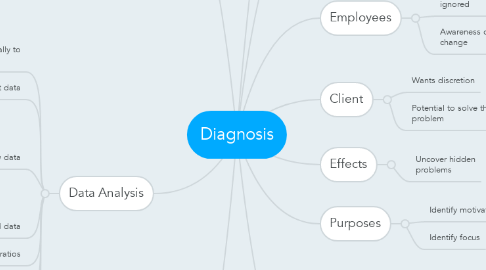Diagnosis
by Denisse Machado


1. Function
1.1. Examine problem faced
1.2. Identify factors
1.3. It is not just giving advice
1.3.1. https://hbr.org/1982/09/consulting-is-more-than-giving-advice
2. Consultant
2.1. Have a framework in mind
2.2. Review problem
2.3. Develeop a picture of the problem
2.4. Plannng is essential
2.5. Choose process
3. Employees
3.1. Find out information they ignored
3.2. Awareness of the need to change
4. Client
4.1. Wants discretion
4.2. Potential to solve the problem
5. Effects
5.1. Uncover hidden problems
6. Purposes
6.1. Identify motivations
6.2. Identify focus
7. Problems
7.1. identiify the exact actual situation
7.2. Problems are very complex
7.3. Organizational and physical location
7.4. Problem ownership
7.5. Absolute and relative magnitude
7.6. Time perspective
7.7. Causes
7.7.1. Forces
7.7.2. Factors
7.8. Mistaking symptoms for problems
8. Data collection
8.1. Get a picture of the probem
8.2. Selectivity
8.3. Degree of detail
8.4. Period of time
8.5. Coverage
8.6. Organization and tabulation of data
8.7. Sources
8.7.1. Records
8.7.2. Events and conditions
8.7.3. Memories
8.7.4. Observation
8.7.5. Questionaires and interviews
8.7.6. Surveys
9. Data Analysis
9.1. Analysis evolves gradually to synthesis.
9.2. Edit data
9.3. Classify data
9.3.1. Time
9.3.2. Place
9.3.3. Responsibility
9.3.4. Structure
9.4. Analyse organized data
9.5. Use ratios
9.6. Compare data
9.7. Analyze the future
9.8. Make a synthesis
10. Feedback to the client
10.1. When you have enough information
10.2. To those from whom the consultant expects help
10.3. Only share important imformation
10.4. Hold feedback meetings
10.5. Give assighnments
10.6. Close diagnosis phase
10.7. Feedback is NOT evaluating the client. Avoid judgements
10.7.1. http://tinyurl.com/zjtyy5c
